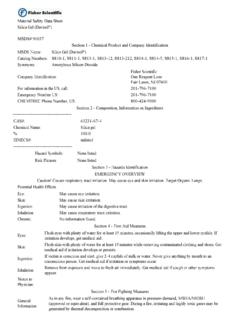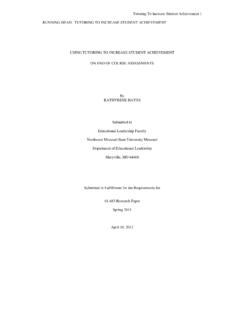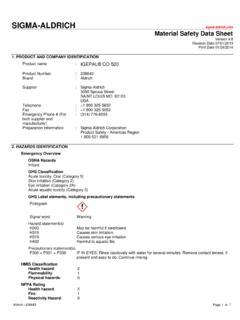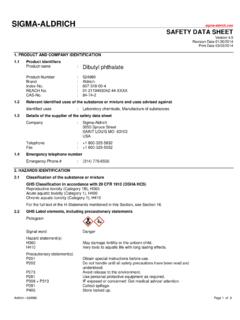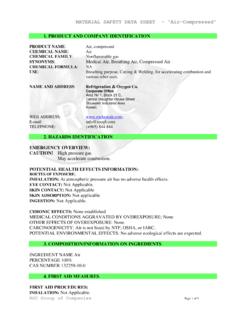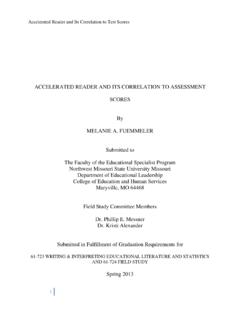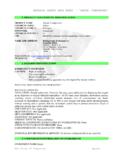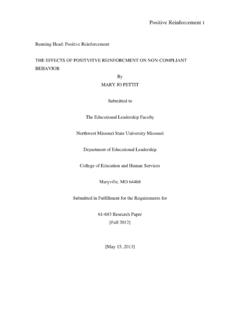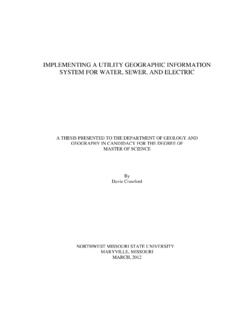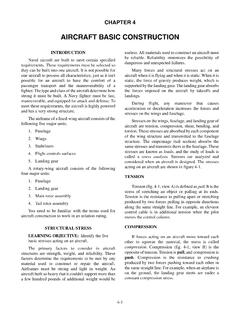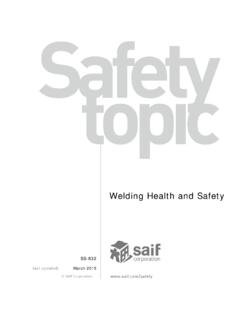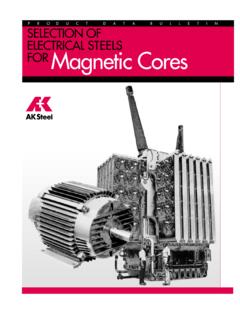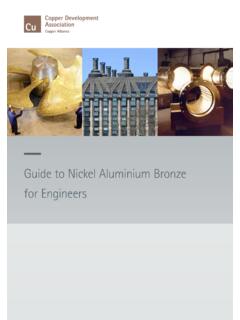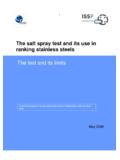Transcription of Page 1 4 STEEL MATERIAL SAFETY DATA SHEET
1 Page 1 of 4. STEEL MATERIAL SAFETY DATA SHEET . MATERIAL IDENTIFICATION AND USE. SUPPLIER: RUSSEL METALS INC. MATERIAL NAME: STEEL . ADDRESS: 1900 MINNESOTA COURT, MISSISSAUGA, SYNONYMS: Includes all SHEET products, ONTARIO. CANADA. L5N 3C9. Plate, Strip, Bar, Slab, Ingot, Structural shapes and Tubular TEL: 905-819-7295. Products. FAX: 905-819-7262. WHMIS CLASS: D2A, D2B FORM #: MSDS-01-2011. DATE: NOVEMBER 2011. 1. PRODUCT INFORMATION. MATERIAL NAME: STEEL . FORM #: MSDS-01-2011 DATE: NOVEMBER 2011. MATERIAL USE: MANUFACTURE OF ARTICLES. 2. HAZARDOUS INGREDIENTS. BASE METAL (ALL VALUES ARE EXPRESSED AS WEIGHT PERCENT AND ARE APPROXIMATES). A Threshold Limit Value (TLV) has not been established for STEEL overall. The listing below is a summary of the elements used in the Russel STEEL products. The exposure limit for iron-containing fumes has been established at 5 mg/m3 (as iron oxide - respirable) with ACGIH's TLV.
2 The individual complex compounds within the fume may have lower exposure limits than the general fume. COMPONENT TLV ACGIH LD50 CARBON & ELECTRICAL LEADED & RAILS & TUBULAR. NUMBER (mg/m ) STEELS LOW ALLOY TIE PROD. STEELS STEELS PLATES. IRON 7439-89-6 (as Iron Oxide - Respirable) U 91-99 91-99 92-96 94-96 94-96. MANGANESE 7439-96-5 (as inorganic Mn) 9000 mg/kg < < < < < Oral-Rat CHROMIUM 7440-47-3 (Metal & Cr+3) U < < < < < (Cr +6 Soluble). (Cr +6 Insoluble). NICKEL 7440-02-0 (Metal, Inhalable) >9000 mg/kg < < < < < (Insoluble, Inhalable) Oral-Rat (Soluble, Inhalable). COPPER 7440-50-8 (Dust) U < -- -- < < (Fume). PHOSPHOROUS 7723-14-0 (Yellow) U < -- -- -- < MOLYBDENUM 7439-98-7 (Insoluble, Inhalable) U -- -- -- < < (Insoluble, Respirable). (Soluble, Respirable ). LEAD 7439-92-1 (Elemental & Inorganic U -- -- < -- -- Compounds as Lead).
3 NOTES: Threshold Limit Values (TLV) established by the American Conference of Governmental Industrial Hygienists (ACGIH - 2011) are 8-hour Time Weighted Average concentrations unless otherwise noted. Ingredients listed as required by the WHMIS Ingredient Disclosure List of the Hazardous Products Act (Canada). For exact composition, refer to analysis or specifications. METALLIC AND NON-METALLIC COATINGS. GALVANIZE - Hot dipped Zinc (CAS 7440-66-6) coating. C2 COATING - Glass film composed of Magnesium ortho-silicate formed GALVANNEAL Coating weights range from 15-400 g/m per ELECTRICAL during high temperature anneal side. May be chemically passivated with a Chromium compound which leaves a residual C3 COATING - Oil modified polyester resin varnish film Cr level of 11-40 mg/m per side. Petroleum ELECTRICAL. based rust preventative oils are applied to oiled product.
4 Typical oil coating weights range C5M COATING - An inorganic iron-silicate complex that is heat and oil from g/m per side. ELECTRICAL resistant with good insulating properties. GALVALUME - Hot dipped Zinc (CAS 7440-66-6) 43% and DRY-LUBE - Mixture of borate and carbonate soap lubricants for metal Aluminum (CAS 7429-90-5) 55% coating. forming. Coating weights range from 50-150 g/m per side. May also be passivated or oiled similar to PRE-LUBE - Petroleum based oil coating used for metal forming Galvanize MATERIAL . LUBE OIL - Lubricating protective petroleum based oil TIN PLATE - Electroplated with tin (CAS 7440-31-5) coating. SLUSHING OIL - Mineral oil based protective coating containing small Coating weights range from g/m per quantities of anti-oxidants side. Treated with Chromium passivation solution which leaves a Chromium residue of VANISHING OIL - Solvent applied petroleum oil protective coating leaving a g/m per side.
5 May be coated with an wax-like protective coating. edible oil to prevent scratching. Oil coating typically micro inches thick. Page 2 of 4. STEEL MATERIAL SAFETY DATA SHEET . PRECOATED - Cured paint/resin film applied to SHEET STEEL . Galvanized or Galvalume coated STEEL SHEET . CHROMIUM - Electroplated with Chromium (CAS 7440-47-3) ZINCROMETAL - Protective coating of zinc rich paint over a chromate based coating. Coating weights range from primer compound. Coating is applied to one side of strip. g/m per side. May be coated with edible oil Typical coating weights range from similar to tin plate. g/m . RUST - Oil based rust inhibitor (Rust Ban 392) PRIMER - Standard Shop Primer Coating for STEEL (#27452 Canam PROTECTION containing 60-100% light hydrotreated distillates Grey), based on 10-20% light aliphatic naphtha solvent (CAS 64742-47-8).
6 (CAS 64742-89-8), 5-10% petroleum distillates (CAS 68410-16- 2) and 5-10% Stoddard solvent (CAS 8052-41-3). NOTES: 1. Individual coating components are present at values below the reporting requirements of the WHMIS Ingredient Disclosure List. 2. Passivation Treatment (specifically ordered) for Zinc Coated Products may contain hexavalent chromium as a portion of the chromium and chromium oxide corrosion protection coating. In these cases, the actual concentration of hexavalent present varies with STEEL gauge and coating weight. 3. HAZARDS IDENTIFICATION. ROUTES OF ENTRY: None in its natural solid state. This formed solid metal product poses little or no immediate health or fire hazard. When product is subjected to welding, burning, melting, sawing, brazing, grinding or other similar processes, potentially hazardous airborne particulate and fumes may be generated.
7 High concentrations of dust may cause irritation to the eyes. Prolonged skin contact with coated STEEL may cause skin irritation in sensitive individuals. Inhalation of metal particulate or elemental oxide fumes generated during welding, burning, grinding or machining may pose acute or chronic health effects. TARGET ORGANS: Respiratory system. EFFECTS OF ACUTE EXPOSURE TO MATERIAL : MANGANESE & COPPER: Inhalation overexposure to manganese or copper (or zinc coated products) may cause metal fume fever characterized by fever and chills ( flu-like symptoms) which appear 4-6 hours after exposure with no long-term effects. EFFECTS OF CHRONIC EXPOSURE TO MATERIAL : CHROMIUM: IARC lists certain hexavalent chromium compounds under its Group 1 category - confirmed human carcinogens and metallic chromium under its Group 3 category - not classifiable as to their carcinogenicity to humans.
8 IRON: Inhalation overexposures may cause a benign pneumoconiosis (siderosis) with few or no symptoms. LEAD: Chronic exposures may cause lead poisoning that can affect the digestive system, nervous system, reproductive systems, muscles and joints. IARC lists lead and its inorganic compounds under its Group 2B. category - possibly carcinogenic to humans . MANGANESE: Existing studies are inadequate to assess its carcinogenicity. Susceptible to Parkinson's disease, metal fume fever and kidney damage. NICKEL: IARC lists metallic nickel under its Group 2B category - possibly carcinogenic to humans . Nickel may cause skin sensitivity. NOTES: International Agency for Research on Cancer (IARC) - Summaries & Evaluations (2008). 3rd Annual Report on Carcinogens as prepared by the National Toxicology Program (NTP). 4. FIRST AID MEASURES. EYES: FLUSH EYES WITH PLENTY OF WATER FOR AT LEAST 15 MINUTES.
9 SEEK MEDICAL ATTENTION IF EYE IRRITATION PERSISTS. SKIN: MAINTAIN GOOD PERSONAL HYGIENE. WASH AFFECTED AREA WITH MILD SOAP AND WATER. SEEK MEDICAL ATTENTION IF SKIN IRRITATION PERSISTS. INHALATION: REMOVE TO FRESH AIR. CHECK FOR CLEAR AIRWAY, BREATHING AND PRESENCE OF PULSE. IF NECESSARY ADMINISTER CPR. CONSULT A PHYSICIAN IMMEDIATELY. INGESTION: RARE IN INDUSTRY. DUST MAY IRRITATE MOUTH AND GASTROINTESTINAL TRACT. IF INGESTED, SEEK MEDICAL ATTENTION PROMPTLY. 5. FIRE FIGHTING MEASURES. FLAMMABILITY CLASSIFICATION: Non-flammable. Will not support combustion. MEANS OF EXTINCTION: Not applicable for solid product. Use extinguishers appropriate for surrounding materials. FLASH POINT ( C): N/A AUTO-IGNITION TEMP ( C): N/A. UPPER FLAMMABLE LIMIT % BY VOL.: N/A LOWER FLAMMABLE LIMIT % BY VOL.: N/A. SENSITIVITY TO STATIC DISCHARGE: N/A EXPLOSION DATA (SENSITIVITY TO IMPACT): No HAZARDOUS COMBUSTION PRODUCTS: At temperatures above the melting point, fumes containing metal oxides and other alloying elements may be liberated.
10 UNUSUAL FIRE HAZARDS: None for this product. Do not use water on molten metal. SPECIAL FIRE FIGHTING: None for this product. 6. ACCIDENTAL RELEASE MEASURES. LEAK AND SPILL PROCEDURES: Not applicable to STEEL in solid state. For spills involving fine dusts, remove by vacuuming or wet sweeping methods to prevent spreading of dust. Avoid inhalation of dusts. Page 3 of 4. STEEL MATERIAL SAFETY DATA SHEET . 7. HANDLING AND STORAGE. HANDLING: Operations with the potential for generating high concentrations of airborne particulates should be evaluated and controlled as necessary. Practice good housekeeping. Avoid breathing metal fumes and/or dust. STORAGE: Store away from acids and incompatible materials. 8. EXPOSURE CONTROLS. ENGINEERING CONTROLS: ( ventilation, enclosures, specify) General or local exhaust during welding or grinding operations.
